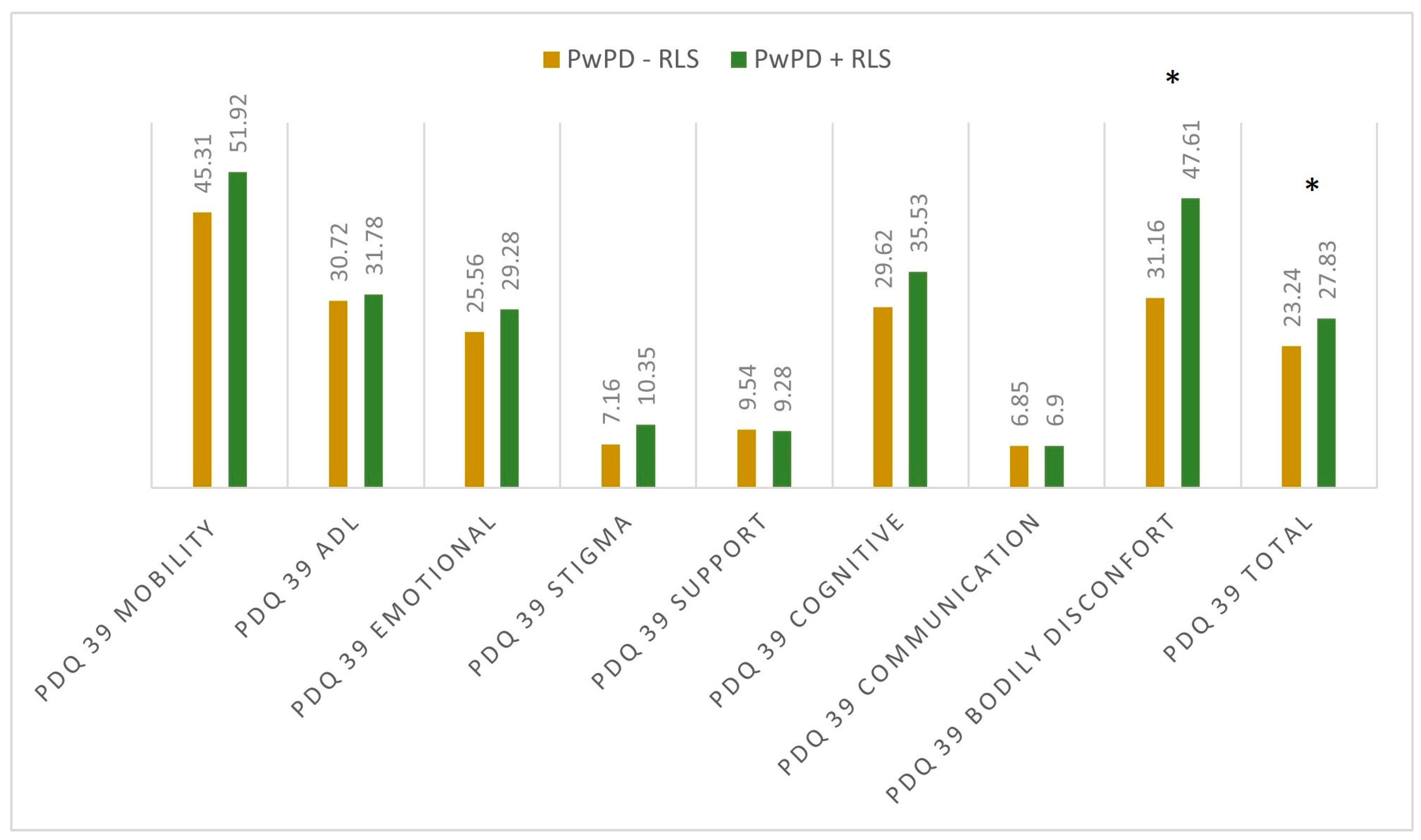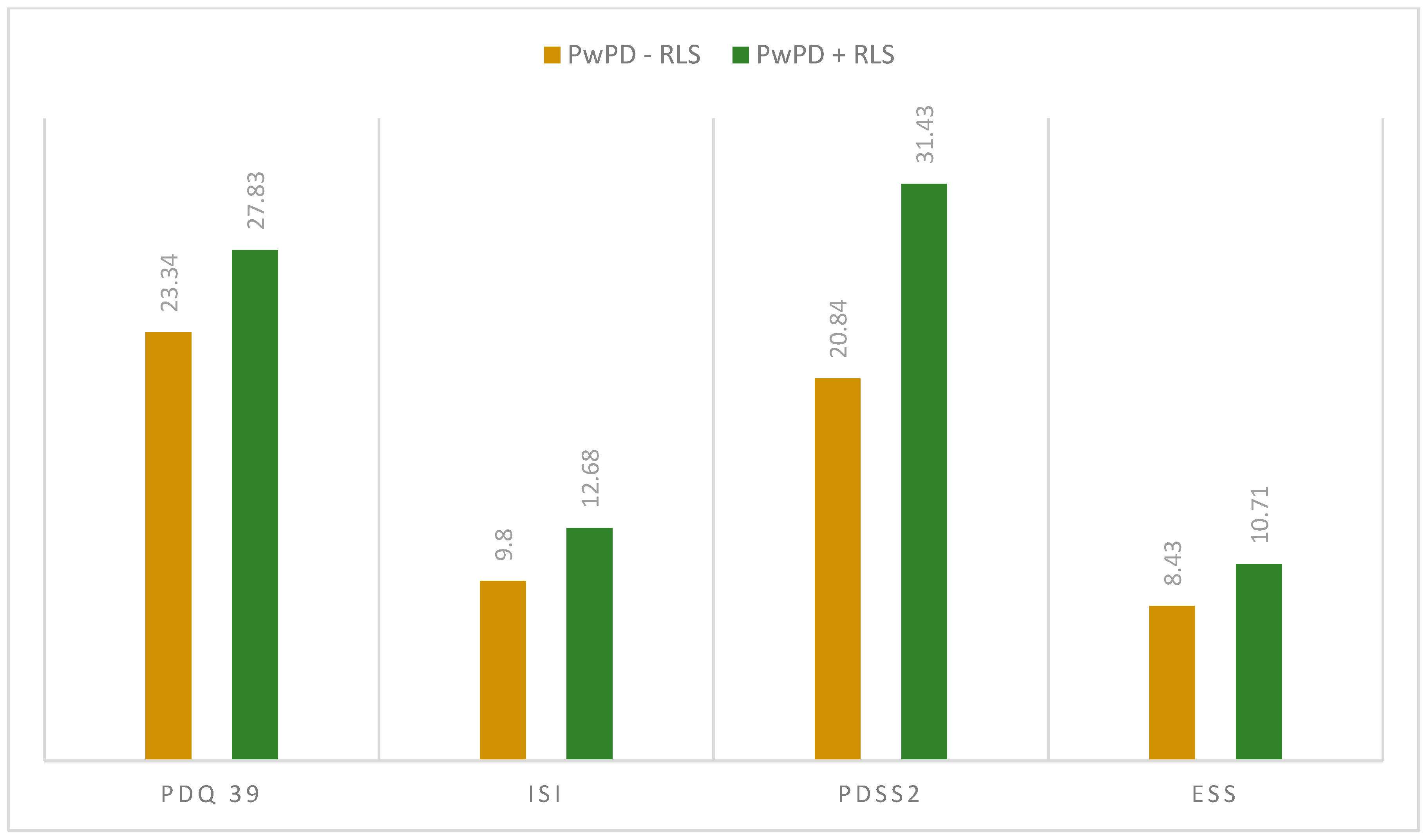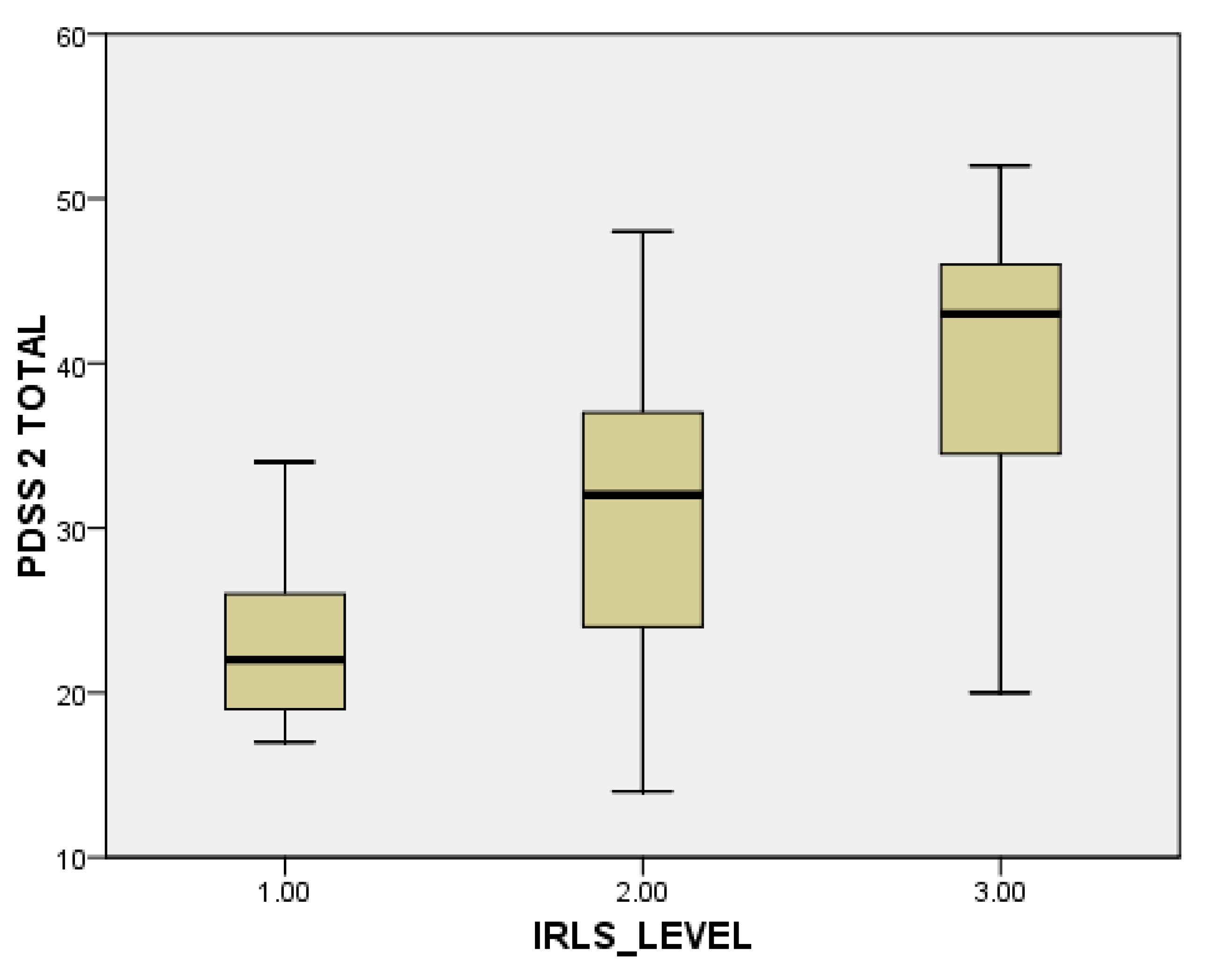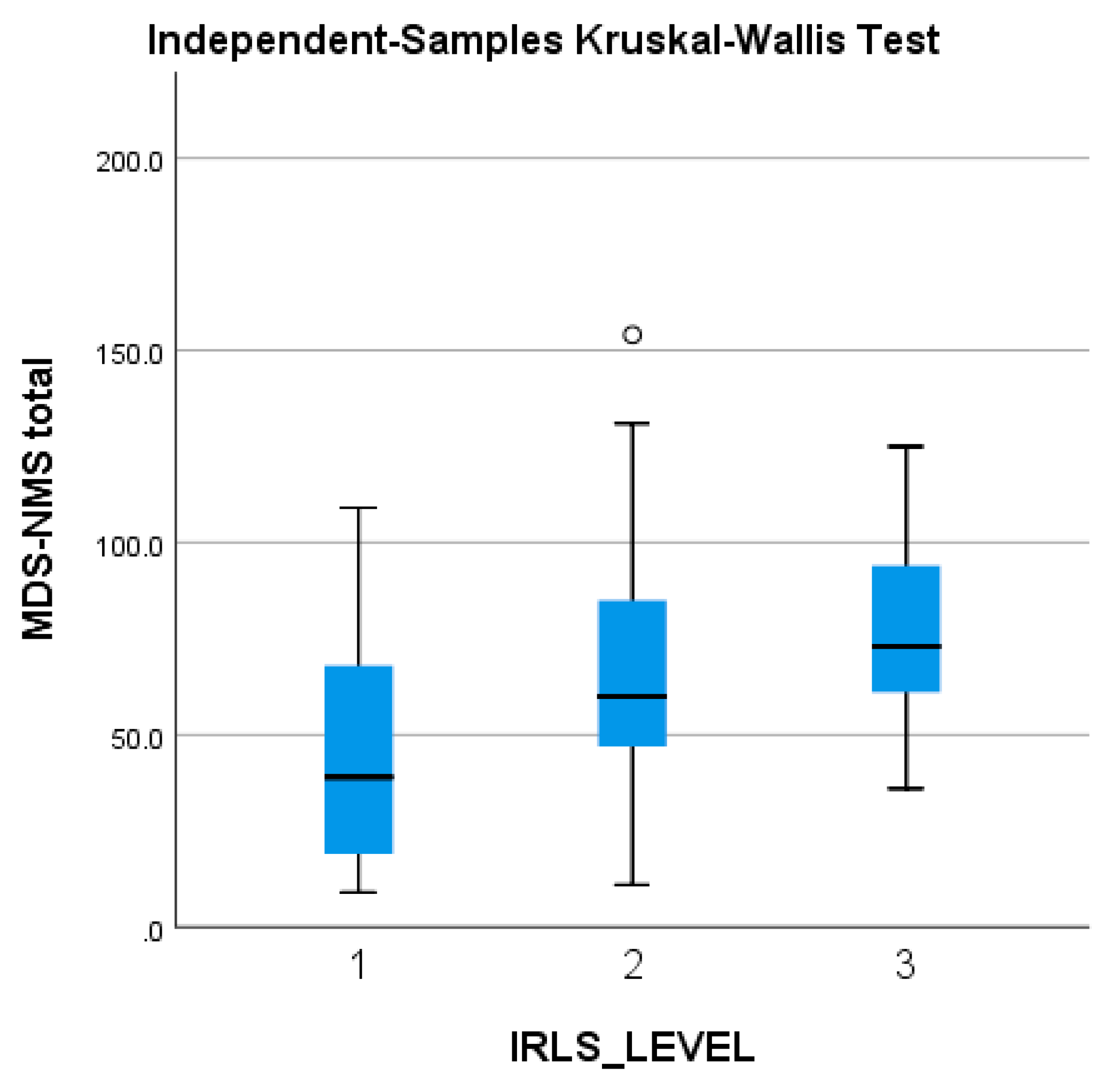Restless Legs Syndrome in Parkinson’s Disease
Abstract
1. Introduction
2. Materials and Methods
2.1. Patients and Study Design
2.2. Questionnaires
2.3. Data Analysis
3. Results
4. Discussion
5. Conclusions
Author Contributions
Funding
Institutional Review Board Statement
Informed Consent Statement
Data Availability Statement
Conflicts of Interest
References
- Allen, R.P.; Picchietti, D.; Hening, W.A.; Trenkwalder, C.; Walters, A.S.; Montplaisi, J. Restless legs syndrome: Diagnostic criteria, special considerations, and epidemiology. A report from the restless legs syndrome diagnosis and epidemiology workshop at the National Institutes of Health. Sleep Med. 2003, 4, 101–119. [Google Scholar] [CrossRef]
- Allen, R.P.; Picchietti, D.L.; Garcia-Borreguero, D.; Ondo, W.G.; Walters, A.S.; Winkelman, J.W.; Zucconi, M.; Ferri, R.; Trenkwalder, C.; Lee, H.B. Restless legs syndrome/Willis-Ekbom disease diagnostic criteria: Updated International Restless Legs Syndrome Study Group (IRLSSG) consensus criteria—History, rationale, description, and significance. Sleep Med. 2014, 15, 860–873. [Google Scholar] [CrossRef]
- Winkelmann, J.; Wetter, T.C.; Collado-Seidel, V.; Gasser, T.; Dichgans, M.; Yassouridis, A.; Trenkwalder, C. Clinical characteristics and frequency of the hereditary restless legs syndrome in a population of 300 patients. Sleep 2000, 23, 597–602. [Google Scholar] [CrossRef]
- Khachatryan, S.G.; Ferri, R.; Fulda, S.; Garcia-Borreguero, D.; Manconi, M.; Muntean, M.L.; Stefani, A. Restless legs syndrome: Over 50 years of European contribution. J. Sleep Res. 2022, 31, e13632. [Google Scholar] [CrossRef]
- Tison, F.; Crochard, A.; Léger, D.; Bouée, S.; Lainey, E.; El Hasnaoui, A. Epidemiology of restless legs syndrome in French adults: A nationwide survey: The INSTANT Study. Neurology 2005, 65, 239–246. [Google Scholar] [CrossRef]
- Castillo-Torres, S.A.; Ibarra-Sifuentes, H.R.; Sánchez-Terán, H.; Sánchez-Martínez, C.; Chávez-Luévanos, B.; Estrada-Bellmann, I. Restless legs syndrome in end-stage renal disease patients undergoing hemodialysis. Arq. Neuropsiquiatr. 2018, 76, 827–830. [Google Scholar] [CrossRef]
- Gupta, R.; Gupta, R.; Kumar, N.; Rawat, V.S.; Ulfberg, J.; Allen, R.P. Restless legs syndrome among subjects having chronic liver disease: A systematic review and meta-analysis. Sleep Med. Rev. 2021, 58, 101463. [Google Scholar] [CrossRef]
- Mendes, A.; Silva, V. Possible etiologies of restless legs syndrome in pregnancy: A narrative review. Sleep Sci. 2022, 15, 471–479. [Google Scholar] [CrossRef]
- Taylor-Gjevre, R.M.; Gjevre, J.A.; Skomro, R.; Nair, B. Restless legs syndrome in a rheumatoid arthritis patient cohort. J. Clin. Rheumatol. 2009, 15, 12–15. [Google Scholar] [CrossRef]
- Stehlik, R.; Arvidsson, L.; Ulfberg, J. Restless legs syndrome is common among female patients with fibromyalgia. Eur. Neurol. 2009, 61, 107–111. [Google Scholar] [CrossRef]
- Ozdogar, A.T.; Kalron, A. Restless legs syndrome in people with multiple sclerosis: An updated systematic review and meta-analyses. Mult. Scler. Relat. Disord. 2021, 56, 103275. [Google Scholar] [CrossRef] [PubMed]
- Falup-Pecurariu, C.; Enache, A.; Duca, L.; Fotescu, C.; Falup-Pecurariu, O.; Monescu, V.; Diaconu, Ş.; Sirbu, C.A. Restless legs syndrome in systemic lupus erythematosus: A case-control study. Exp. Ther. Med. 2021, 22, 802. [Google Scholar] [CrossRef]
- Alonso-Navarro, H.; García-Martín, E.; Agúndez, J.A.G.; Jiménez-Jiménez, F.J. Association between restless legs syndrome and other movement disorders. Neurology 2019, 92, 948–964. [Google Scholar] [CrossRef] [PubMed]
- Metta, V.; Chung-Faye, G.; TS Benamer, H.; Mrudula, R.; Goyal, V.; Falup-Pecurariu, C.; Muralidharan, N.; Deepak, D.; Abdulraheem, M.; Borgohain, R.; et al. Hiccups, Hypersalivation, Hallucinations in Parkinson’s Disease: New Insights, Mechanisms, Pathophysiology, and Management. J. Pers. Med. 2023, 13, 711. [Google Scholar] [CrossRef] [PubMed]
- Irincu, L.; Ivan, I.; Diaconu, Ș.; Falup-Pecurariu, C. Impulse control disorders, dopamine dysregulation syndrome and sex dysfunction in Parkinson’s disease. Int. Rev. Neurobiol. 2022, 162, 117–134. [Google Scholar] [CrossRef]
- Högl, B.; Stefani, A. Restless legs syndrome and periodic leg movements in patients with movement disorders: Specific considerations. Mov. Disord. 2017, 32, 669–681. [Google Scholar] [CrossRef]
- Moccia, M.; Erro, R.; Picillo, M.; Santangelo, G.; Spina, E.; Allocca, R.; Longo, K.; Amboni, M.; Palladino, R.; Assante, R.; et al. A Four-Year Longitudinal Study on Restless Legs Syndrome in Parkinson Disease. Sleep 2016, 39, 405–412. [Google Scholar] [CrossRef]
- Ferini-Strambi, L.; Carli, G.; Casoni, F.; Galbiati, A. Restless Legs Syndrome and Parkinson Disease: A Causal Relationship Between the Two Disorders? Front. Neurol. 2018, 9, 551. [Google Scholar] [CrossRef]
- Allen, R.P.; Walters, A.S.; Montplaisir, J.; Hening, W.; Myers, A.; Bell, T.J.; Ferini-Strambi, L. Restless legs syndrome prevalence and impact: REST general population study. Arch. Intern. Med. 2005, 165, 1286–1292. [Google Scholar] [CrossRef]
- Bhalsing, K.; Suresh, K.; Muthane, U.B.; Pal, P.K. Prevalence and profile of Restless Legs Syndrome in Parkinson’s disease and other neurodegenerative disorders: A case-control study. Park. Relat. Disord. 2013, 19, 426–430. [Google Scholar] [CrossRef]
- Sun, S.; Zhao, X.; Ren, J.; Cheng, J.; Zhou, J.; Su, C. Characteristics of Objective Sleep and Its Related Risk Factors Among Parkinson’s Disease Patients With and Without Restless Legs Syndrome. Front. Neurol. 2021, 12, 644385. [Google Scholar] [CrossRef] [PubMed]
- Zhang, L.; Wan, Z.; He, X.; Cheng, L.; Wang, P.; Li, J.; Du, J. The association between restless leg syndrome and anxiety in Parkinson’s disease: A case-control study. Neurol. Res. 2022, 44, 475–482. [Google Scholar] [CrossRef]
- Rana, A.Q.; Mosabbir, A.A.; Qureshi, A.R.; Abbas, M.; Rana, M.A. Restless leg syndrome: A risk factor of higher prevalence of anxiety and depression in Parkinson’s disease patients. Neurol. Res. 2016, 38, 309–312. [Google Scholar] [CrossRef] [PubMed]
- Diaconu, Ş.; Falup-Pecurariu, C. Personalized Assessment of Insomnia and Sleep Quality in Patients with Parkinson’s Disease. J. Pers. Med. 2022, 12, 322. [Google Scholar] [CrossRef] [PubMed]
- Postuma, R.B.; Berg, D.; Stern, M.; Poewe, W.; Olanow, C.W.; Oertel, W.; Obeso, J.; Marek, K.; Litvan, I.; Lang, A.E.; et al. MDS clinical diagnostic criteria for Parkinson’s disease. Mov. Disord. 2015, 30, 1591–1601. [Google Scholar] [CrossRef] [PubMed]
- Walters, A.S.; LeBrocq, C.; Dhar, A.; Hening, W.; Rosen, R.; Allen, R.P.; Trenkwalder, C. Validation of the International Restless Legs Syndrome Study Group rating scale for restless legs syndrome. Sleep Med. 2003, 4, 121–132. [Google Scholar] [CrossRef]
- Trenkwalder, C.; Kohnen, R.; Högl, B.; Metta, V.; Sixel-Döring, F.; Frauscher, B.; Hülsmann, J.; Martinez-Martin, P.; Chaudhuri, K.R. Parkinson’s disease sleep scale--validation of the revised version PDSS-2. Mov. Disord. 2011, 26, 644–652. [Google Scholar] [CrossRef]
- Chaudhuri, K.R.; Pal, S.; DiMarco, A.; Whately-Smith, C.; Bridgman, K.; Mathew, R.; Pezzela, F.R.; Forbes, A.; Högl, B.; Trenkwalder, C. The Parkinson’s disease sleep scale: A new instrument for assessing sleep and nocturnal disability in Parkinson’s disease. J. Neurol. Neurosurg. Psychiatry 2002, 73, 629–635. [Google Scholar] [CrossRef]
- Bastien, C.H.; Vallières, A.; Morin, C.M. Validation of the Insomnia Severity Index as an outcome measure for insomnia research. Sleep Med. 2001, 2, 297–307. [Google Scholar] [CrossRef]
- Johns, M.W. A new method for measuring daytime sleepiness: The Epworth sleepiness scale. Sleep 1991, 14, 540–545. [Google Scholar] [CrossRef]
- Jenkinson, C.; Fitzpatrick, R.; Peto, V.; Greenhall, R.; Hyman, N. The Parkinson’s Disease Questionnaire (PDQ-39): Development and validation of a Parkinson’s disease summary index score. Age Ageing 1997, 26, 353–357. [Google Scholar] [CrossRef] [PubMed]
- Chaudhuri, K.R.; Martinez-Martin, P.; Schapira, A.H.; Stocchi, F.; Sethi, K.; Odin, P.; Brown, R.G.; Koller, W.; Barone, P.; MacPhee, G.; et al. International multicenter pilot study of the first comprehensive self-completed nonmotor symptoms questionnaire for Parkinson’s disease: The NMSQuest study. Mov. Disord. 2006, 21, 916–923. [Google Scholar] [CrossRef] [PubMed]
- Chaudhuri, K.R.; Martinez-Martin, P.; Brown, R.G.; Sethi, K.; Stocchi, F.; Odin, P.; Ondo, W.; Abe, K.; Macphee, G.; Macmahon, D.; et al. The metric properties of a novel non-motor symptoms scale for Parkinson’s disease: Results from an international pilot study. Mov. Disord. 2007, 22, 1901–1911. [Google Scholar] [CrossRef]
- Chaudhuri, K.R.; Schrag, A.; Weintraub, D.; Rizos, A.; Rodriguez-Blazquez, C.; Mamikonyan, E.; Martinez-Martin, P. The movement disorder society nonmotor rating scale: Initial validation study. Mov. Disord. 2020, 35, 116–133. [Google Scholar] [CrossRef] [PubMed]
- Zigmond, A.S.; Snaith, R.P. The hospital anxiety and depression scale. Acta Psychiatr. Scand. 1983, 67, 361–370. [Google Scholar] [CrossRef]
- Zadikoff, C.; Fox, S.H.; Tang-Wai, D.F.; Thomsen, T.; de Bie, R.M.; Wadia, P.; Miyasaki, J.; Duff-Canning, S.; Lang, A.E.; Marras, C. A comparison of the mini mental state exam to the Montreal cognitive assessment in identifying cognitive deficits in Parkinson’s disease. Mov. Disord. 2008, 23, 297–299. [Google Scholar] [CrossRef] [PubMed]
- Fiorenzato, E.; Weis, L.; Falup-Pecurariu, C.; Diaconu, S.; Siri, C.; Reali, E.; Pezzoli, G.; Bisiacchi, P.; Antonini, A.; Biundo, R. Montreal Cognitive Assessment (MoCA) and Mini-Mental State Examination (MMSE) performance in progressive supranuclear palsy and multiple system atrophy. J. Neural Transm. 2016, 123, 1435–1442. [Google Scholar] [CrossRef] [PubMed]
- Marinus, J.; Visser, M.; Stiggelbout, A.M.; Rabey, J.M.; Martínez-Martín, P.; Bonuccelli, U.; Kraus, P.H.; van Hilten, J.J. A short scale for the assessment of motor impairments and disabilities in Parkinson’s disease: The SPES/SCOPA. J. Neurol. Neurosurg. Psychiatry 2004, 75, 388–395. [Google Scholar] [CrossRef]
- Svensson, E.; Beiske, A.G.; Loge, J.H.; Beiske, K.K.; Sivertsen, B. Sleep problems in Parkinson’s disease: A community-based study in Norway. BMC Neurol. 2012, 12, 71. [Google Scholar] [CrossRef]
- Ondo, W.G.; Vuong, K.D.; Jankovic, J. Exploring the relationship between Parkinson disease and restless legs syndrome. Arch. Neurol. 2002, 59, 421–424. [Google Scholar] [CrossRef]
- Gómez-Esteban, J.C.; Zarranz, J.J.; Tijero, B.; Velasco, F.; Barcena, J.; Rouco, I.; Lezcano, E.; Lachen, M.C.; Jauregui, A.; Ugarte, A. Restless legs syndrome in Parkinson’s disease. Mov. Disord. 2007, 22, 1912–1916. [Google Scholar] [CrossRef] [PubMed]
- Fereshtehnejad, S.M.; Shafieesabet, M.; Shahidi, G.A.; Delbari, A.; Lökk, J. Restless legs syndrome in patients with Parkinson’s disease: A comparative study on prevalence, clinical characteristics, quality of life and nutritional status. Acta Neurol. Scand. 2015, 131, 211–218. [Google Scholar] [CrossRef] [PubMed]
- Oh, Y.S.; Kim, J.S.; Park, I.S.; Song, I.U.; Son, Y.M.; Park, J.W.; Yang, D.W.; Kim, H.T.; Lee, K.S. Association between nocturnal/supine hypertension and restless legs syndrome in patients with Parkinson’s disease. J. Neurol. Sci. 2014, 344, 186–189. [Google Scholar] [CrossRef] [PubMed]
- Suzuki, K.; Okuma, Y.; Uchiyama, T.; Miyamoto, M.; Sakakibara, R.; Shimo, Y.; Hattori, N.; Kuwabara, S.; Yamamoto, T.; Kaji, Y.; et al. Characterizing restless legs syndrome and leg motor restlessness in patients with Parkinson’s disease: A multicenter case-controlled study. Park. Relat. Disord. 2017, 44, 18–22. [Google Scholar] [CrossRef] [PubMed]
- Garcia-Borreguero, D.; Egatz, R.; Winkelmann, J.; Berger, K. Epidemiology of restless legs syndrome: The current status. Sleep Med. Rev. 2006, 10, 153–167. [Google Scholar] [CrossRef]
- Loo, H.V.; Tan, E.K. Case-control study of restless legs syndrome and quality of sleep in Parkinson’s disease. J. Neurol. Sci. 2008, 266, 145–149. [Google Scholar] [CrossRef] [PubMed]
- Krishnan, P.R.; Bhatia, M.; Behari, M. Restless legs syndrome in Parkinson’s disease: A case-controlled study. Mov. Disord. 2003, 18, 181–185. [Google Scholar] [CrossRef]
- Nomura, T.; Inoue, Y.; Miyake, M.; Yasui, K.; Nakashima, K. Prevalence and clinical characteristics of restless legs syndrome in Japanese patients with Parkinson’s disease. Mov. Disord. 2006, 21, 380–384. [Google Scholar] [CrossRef]
- Piao, Y.S.; Lian, T.H.; Hu, Y.; Zuo, L.J.; Guo, P.; Yu, S.Y.; Liu, L.; Jin, Z.; Zhao, H.; Li, L.X.; et al. Restless legs syndrome in Parkinson disease: Clinical characteristics, abnormal iron metabolism and altered neurotransmitters. Sci. Rep. 2017, 7, 10547. [Google Scholar] [CrossRef]
- Shin, H.Y.; Youn, J.; Yoon, W.T.; Kim, J.S.; Cho, J.W. Restless legs syndrome in Korean patients with drug-naïve Parkinson’s disease: A nation-wide study. Park. Relat. Disord. 2013, 19, 355–358. [Google Scholar] [CrossRef]
- Kwon, D.Y.; Seo, W.K.; Yoon, H.K.; Park, M.H.; Koh, S.B.; Park, K.W. Transcranial brain sonography in Parkinson’s disease with restless legs syndrome. Mov. Disord. 2010, 25, 1373–1378. [Google Scholar] [CrossRef] [PubMed]
- Linke, R.; Eisensehr, I.; Wetter, T.C.; Gildehaus, F.J.; Pöpperl, G.; Trenkwalder, C.; Noachtar, S.; Tatsch, K. Presynaptic dopaminergic function in patients with restless legs syndrome: Are there common features with early Parkinson’s disease? Mov. Disord. 2004, 19, 1158–1162. [Google Scholar] [CrossRef] [PubMed]
- Ondo, W.G.; Zhao, H.R.; Le, W.D. Animal models of restless legs syndrome. Sleep Med. 2007, 8, 344–348. [Google Scholar] [CrossRef] [PubMed]
- You, S.; Jeon, S.M.; Do, S.Y.; Cho, Y.W. Restless Legs Syndrome in Parkinson’s Disease Patients: Clinical Features Including Motor and Nonmotor Symptoms. J. Clin. Neurol. 2019, 15, 321–327. [Google Scholar] [CrossRef] [PubMed]
- Cederberg, K.L.; Brinkley, E.B.; Belotserkovkaya, N.; Memon, R.A.; Motl, R.W.; Amara, A.W. Does restless legs syndrome impact cognitive function via sleep quality in adults with Parkinson’s disease? Int. J. Neurosci. 2020, 130, 322–329. [Google Scholar] [CrossRef]
- Verbaan, D.; van Rooden, S.M.; van Hilten, J.J.; Rijsman, R.M. Prevalence and clinical profile of restless legs syndrome in Parkinson’s disease. Mov. Disord. 2010, 25, 2142–2147. [Google Scholar] [CrossRef]
- Sauerbier, A.; Sivakumar, C.; Klingelhoefer, L.; Martinez-Martin, P.; Perkins, L.; Inniss, R.; Rizos, A.; Trivedi, D.; Leta, V.; Wan, Y.M.; et al. Restless legs syndrome—The under-recognised non-motor burden: A questionnaire-based cohort study. Postgrad. Med. 2019, 131, 473–478. [Google Scholar] [CrossRef]
- Sobreira-Neto, M.A.; Pena-Pereira, M.A.; Sobreira, E.S.T.; Chagas, M.H.N.; Almeida, C.M.O.; Fernandes, R.M.F.; Tumas, V.; Eckeli, A.L. Is restless legs syndrome in Parkinson disease patients associated with any specific factor? Arq. Neuropsiquiatr. 2021, 79, 38–43. [Google Scholar] [CrossRef]
- Paul, D.A.; Qureshi, A.R.; Jamal, M.K.; Rana, A.Q. Cross-Sectional Design: Link Between Parkinson’s Pain and Restless Leg Syndrome. J. Geriatr. Psychiatry Neurol. 2022, 35, 622–626. [Google Scholar] [CrossRef]
- Rana, A.Q.; Siddiqui, I.; Mosabbir, A.; Athar, A.; Syed, O.; Jesudasan, M.; Hafez, K. Association of pain, Parkinson’s disease, and restless legs syndrome. J. Neurol. Sci. 2013, 327, 32–34. [Google Scholar] [CrossRef]
- Ylikoski, A.; Martikainen, K.; Partinen, M. Parkinson’s disease and restless legs syndrome. Eur. Neurol. 2015, 73, 212–219. [Google Scholar] [CrossRef] [PubMed]
- Lin, S.W.; Chen, Y.L.; Kao, K.C.; Yang, C.T.; Chuang, L.P.; Chou, Y.T.; Lai, S.C.; Chen, R.S.; Chen, N.H. Diseases in patients coming to a sleep center with symptoms related to restless legs syndrome. PLoS ONE 2013, 8, e71499. [Google Scholar] [CrossRef] [PubMed]
- Lakshminarayanan, S.; Paramasivan, K.D.; Walters, A.S.; Wagner, M.L.; Patel, S.; Passi, V. Clinically significant but unsuspected restless legs syndrome in patients with sleep apnea. Mov. Disord. 2005, 20, 501–503. [Google Scholar] [CrossRef] [PubMed]
- Roux, F.J. Restless legs syndrome: Impact on sleep-related breathing disorders. Respirology 2013, 18, 238–245. [Google Scholar] [CrossRef]




| PwPD + RLS N = 35 (M/F) | PwPD − RLS N = 96 (M/F) | p-Value | |
|---|---|---|---|
| Sex | 20/15 | 46/50 | 0.431 |
| LEDD (mean, mg) | 459.88 | 505.4 | 0.434 |
| Age (years ± SD) | 74.51 (±8.38) | 74.38 (±9.23) | 0.325 |
| Age at PD onset (years ± SD) | 68.303 (±10.69) | 69.66 (±9.89) | 0.347 |
| Duration of PD (years ± SD) | 6.43(±5.377) | 4.58 (±3.66) | 0.367 |
| PwPD + RLS N = 35 | PwPD − RLS N = 96 | p-Value | |
|---|---|---|---|
| Motor symptoms | |||
| MDS-UPDRS III | 36.45 (±11.02) | 31.17 (±14.22) | 0.009 |
| MDS-UPDRS IV | 3.46 (±2.61) | 3.44 (±3.27) | 0.114 |
| H&Y | 2.42 (±0.60) | 2.38 (±0.79) | 0.415 |
| SCOPA-Motor | 24.97 (±7.19) | 21.61 (±9.34) | 0.009 |
| Non-motor symptoms | |||
| IRLSSG | 14.74 (±6.10) | – | <0.001 |
| PDQ 39 | 27.83 (±12.54) | 23.34 (±15.09) | 0.046 |
| ISI | 12.68 (±5.98) | 9.8 (±5.91) | 0.016 |
| PDSS 2 | 31.43 (±10.18) | 20.84 (±9.91) | <0.001 |
| ESS | 10.71 (±4.91) | 8.43 (±5.61) | 0.02 |
| MMSE | 27.54 (±2.33) | 27.19 (±3.69) | 0.786 |
| MoCA | 23.71 (±4.7) | 23.33 (±5.8) | 0.938 |
| HADS Depression | 16.91 (±6.89) | 13.40 (±7.85) | 0.013 |
| HADS Anxiety | 6.55 (±3.71) | 4.97 (±3.76) | 0.027 |
| HADS Total | 10.35 (±3.61) | 8.43 (±4.50) | 0.016 |
| PwPD + RLS | PwPD − RLS | ||||
|---|---|---|---|---|---|
| Mean | Std. Deviation | Mean | Std. Deviation | p | |
| MDS-NMS A. Depression domain total score | 3.629 | 3.5570 | 3.629 | 3.5570 | 0.058 |
| MDS-NMS B. Anxiety total score | 4.000 | 5.5572 | 4.000 | 5.5572 | 0.126 |
| MDS-NMS C. Apathy total score | 1.886 | 2.0113 | 1.886 | 2.0113 | 0.183 |
| MDS-NMS D. Psychosis total score | 0.314 | 0.8668 | 0.314 | 0.8668 | 0.953 |
| MDS-NMS E. Impulse Control Disorders total score | 0.029 | 0.1690 | 0.029 | 0.1690 | 0.463 |
| MDS-NMS F. Cognition total score | 6.514 | 8.1615 | 6.514 | 8.1615 | 0.850 |
| MDS-NMS G. Orthostatic hypotension total score | 3.229 | 6.2830 | 3.229 | 6.2830 | 0.703 |
| MDS-NMS H. Urinary total score | 7.029 | 6.2755 | 7.029 | 6.2755 | 0.314 |
| MDS-NMS I. Sexual total score | 0.314 | 1.5295 | 0.314 | 1.5295 | 0.191 |
| MDS-NMS J. Gastrointestinal total score | 2.000 | 2.4254 | 2.000 | 2.4254 | 0.941 |
| MDS-NMS K. Sleep total score | 15.229 | 10.3216 | 15.229 | 10.3216 | <0.001 |
| Restlessness fr x sev | 3.057 | 3.0673 | 3.057 | 3.0673 | <0.001 |
| Periodic limb movements fr x sev | 1.343 | 2.1955 | 1.343 | 2.1955 | <0.001 |
| Snoring, difficulty breathing fr x sev | 2.000 | 2.1693 | 2.000 | 2.1693 | <0.001 |
| MDS-NMS L. Pain total | 11.743 | 8.4029 | 11.743 | 8.4029 | 0.003 |
| Other types of pain (nocturnal, orofacial) fr x sev | 3.714 | 3.6346 | 3.714 | 3.6346 | 0.002 |
| MDS-NMS M. Other non-motor symptoms total | 11.086 | 7.9164 | 11.086 | 7.9164 | 0.177 |
| Physical fatigue fr x sev | 5.771 | 4.2084 | 5.771 | 4.2084 | 0.007 |
| MDS-NMS total | 67.000 | 35.4119 | 67.000 | 35.4119 | 0.007 |
Disclaimer/Publisher’s Note: The statements, opinions and data contained in all publications are solely those of the individual author(s) and contributor(s) and not of MDPI and/or the editor(s). MDPI and/or the editor(s) disclaim responsibility for any injury to people or property resulting from any ideas, methods, instructions or products referred to in the content. |
© 2023 by the authors. Licensee MDPI, Basel, Switzerland. This article is an open access article distributed under the terms and conditions of the Creative Commons Attribution (CC BY) license (https://creativecommons.org/licenses/by/4.0/).
Share and Cite
Diaconu, Ş.; Irincu, L.; Ungureanu, L.; Ciopleiaș, B.; Țînț, D.; Falup-Pecurariu, C. Restless Legs Syndrome in Parkinson’s Disease. J. Pers. Med. 2023, 13, 915. https://doi.org/10.3390/jpm13060915
Diaconu Ş, Irincu L, Ungureanu L, Ciopleiaș B, Țînț D, Falup-Pecurariu C. Restless Legs Syndrome in Parkinson’s Disease. Journal of Personalized Medicine. 2023; 13(6):915. https://doi.org/10.3390/jpm13060915
Chicago/Turabian StyleDiaconu, Ştefania, Laura Irincu, Larisa Ungureanu, Bogdan Ciopleiaș, Diana Țînț, and Cristian Falup-Pecurariu. 2023. "Restless Legs Syndrome in Parkinson’s Disease" Journal of Personalized Medicine 13, no. 6: 915. https://doi.org/10.3390/jpm13060915
APA StyleDiaconu, Ş., Irincu, L., Ungureanu, L., Ciopleiaș, B., Țînț, D., & Falup-Pecurariu, C. (2023). Restless Legs Syndrome in Parkinson’s Disease. Journal of Personalized Medicine, 13(6), 915. https://doi.org/10.3390/jpm13060915







